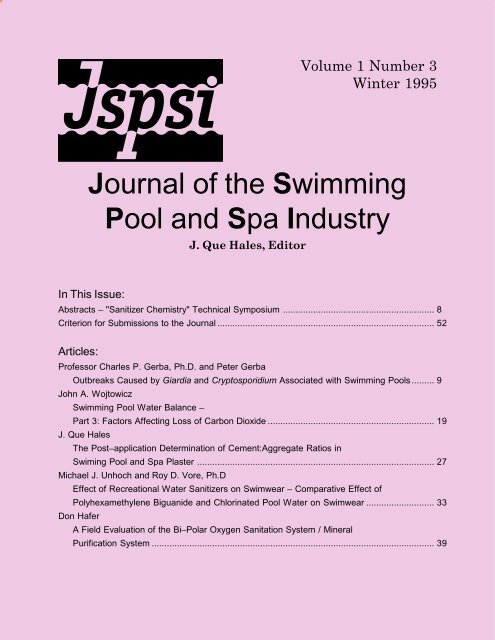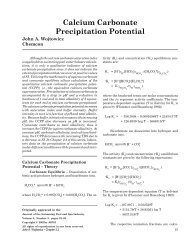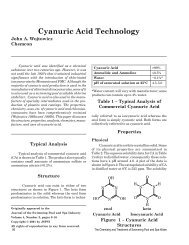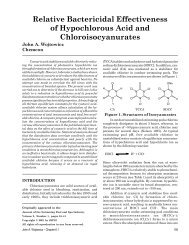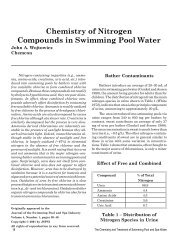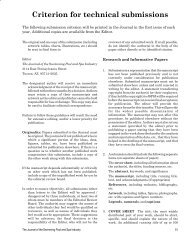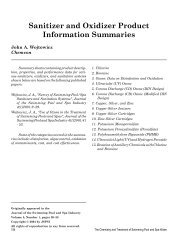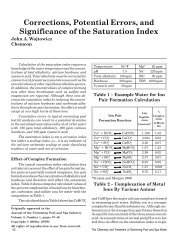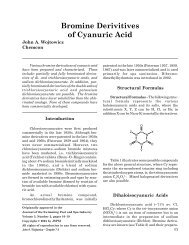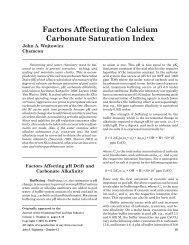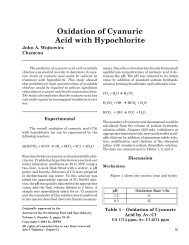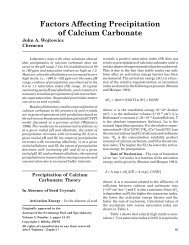Journal of the Swimming Pool and Spa Industry - jspsi - PoolHelp
Journal of the Swimming Pool and Spa Industry - jspsi - PoolHelp
Journal of the Swimming Pool and Spa Industry - jspsi - PoolHelp
You also want an ePaper? Increase the reach of your titles
YUMPU automatically turns print PDFs into web optimized ePapers that Google loves.
In This Issue:<br />
Volume 1 Number 3<br />
Winter 1995<br />
Abstracts � "Sanitizer Chemistry" Technical Symposium ............................................................ 8<br />
Criterion for Submissions to <strong>the</strong> <strong>Journal</strong> ...................................................................................... 52<br />
Articles:<br />
Pr<strong>of</strong>essor Charles P. Gerba, Ph.D. <strong>and</strong> Peter Gerba<br />
Outbreaks Caused by Giardia <strong>and</strong> Cryptosporidium Associated with <strong>Swimming</strong> <strong>Pool</strong>s ......... 9<br />
John A. Wojtowicz<br />
<strong>Swimming</strong> <strong>Pool</strong> Water Balance �<br />
Part 3: Factors Affecting Loss <strong>of</strong> Carbon Dioxide .................................................................. 19<br />
J. Que Hales<br />
The Post�application Determination <strong>of</strong> Cement:Aggregate Ratios in<br />
Swiming <strong>Pool</strong> <strong>and</strong> <strong>Spa</strong> Plaster .............................................................................................. 27<br />
Michael J. Unhoch <strong>and</strong> Roy D. Vore, Ph.D<br />
Effect <strong>of</strong> Recreational Water Sanitizers on Swimwear � Comparative Effect <strong>of</strong><br />
Polyhexamethylene Biguanide <strong>and</strong> Chlorinated <strong>Pool</strong> Water on Swimwear ........................... 33<br />
Don Hafer<br />
<strong>Journal</strong> <strong>of</strong> <strong>the</strong> <strong>Swimming</strong><br />
<strong>Pool</strong> <strong>and</strong> <strong>Spa</strong> <strong>Industry</strong><br />
J. Que Hales, Editor<br />
A Field Evaluation <strong>of</strong> <strong>the</strong> Bi�Polar Oxygen Sanitation System / Mineral<br />
Purification System ................................................................................................................ 39<br />
The <strong>Journal</strong> <strong>of</strong> <strong>the</strong> <strong>Swimming</strong> <strong>Pool</strong> <strong>and</strong> <strong>Spa</strong> <strong>Industry</strong> 1
The <strong>Journal</strong> <strong>of</strong> <strong>the</strong> <strong>Swimming</strong> <strong>Pool</strong> <strong>and</strong><br />
<strong>Spa</strong> <strong>Industry</strong> (JSPSI) publishes papers on all aspects<br />
<strong>of</strong> <strong>the</strong> swimming pool <strong>and</strong> spa industry. Research,<br />
informative papers, bibliographies, book reviews,<br />
<strong>and</strong> symposia– in– print are presented for <strong>the</strong><br />
general education <strong>of</strong> all technically minded individuals<br />
in <strong>the</strong> industry.<br />
The <strong>of</strong>fice <strong>of</strong> <strong>the</strong> Editor is:<br />
J. Que Hales, Editor<br />
The <strong>Journal</strong> <strong>of</strong> <strong>the</strong> <strong>Swimming</strong> <strong>Pool</strong> <strong>and</strong> <strong>Spa</strong> <strong>Industry</strong><br />
3114 East Pennsylvania Street, Tucson, AZ 85714– 2035<br />
phone: (520) 573– 6696<br />
fax: (520) 625– 1918<br />
email: editor@poolhelp.com<br />
All editorial correspondence should be directed<br />
to <strong>the</strong> above address.<br />
Postmaster: Send address changes to The<br />
<strong>Journal</strong> <strong>of</strong> <strong>the</strong> <strong>Swimming</strong> <strong>Pool</strong> <strong>and</strong> <strong>Spa</strong> <strong>Industry</strong>,<br />
3114 East Pennsylvania Street, Tucson, AZ 85714–<br />
2035.<br />
Submission <strong>of</strong> Papers: Instructions for submission<br />
<strong>of</strong> papers appear at <strong>the</strong> end <strong>of</strong> this issue.<br />
Requests for additional information or copies <strong>of</strong> <strong>the</strong><br />
submission criterion should be directed to <strong>the</strong> above<br />
address or phone numbers.<br />
Reprints <strong>and</strong> back issues: Reprints for au-<br />
thors are to be ordered prior to publication. O<strong>the</strong>rs<br />
may order reprints by using <strong>the</strong> coupon included in<br />
<strong>the</strong> back <strong>of</strong> <strong>the</strong> <strong>Journal</strong>, or by contacting <strong>the</strong> <strong>of</strong>fice<br />
<strong>of</strong> <strong>the</strong> Editor. Back issues are available in <strong>the</strong> original<br />
(while <strong>the</strong>y last) or as high– quality photocopies<br />
at <strong>the</strong> single issue price ($15.00).<br />
Photocopies: Authorization to photocopy material<br />
o<strong>the</strong>r than under circumstances falling under<br />
<strong>the</strong> Fair Use provisions <strong>of</strong> <strong>the</strong> Copyright Act must<br />
be secured from <strong>the</strong> Editor.<br />
Subscriptions: 1995 subscription rates are<br />
$50.00 annually. U.S. periodical postage is paid at<br />
Tucson, Arizona. International postage is in addition<br />
to <strong>the</strong> subscription rate:<br />
International Surface Mail $8.00 annually<br />
International Air Mail $15.00 annually<br />
Single copies are $15.00. Introductory discounts<br />
may be available for members <strong>of</strong> certain qualifying<br />
associations, including NSPI, NSPF, SPWTP, NPC,<br />
IPPSA, <strong>and</strong> UPA. Contact <strong>the</strong> Editor for fur<strong>the</strong>r information.<br />
Subscriptions are for one year (or four<br />
issues), <strong>and</strong> must be prepaid. Notify <strong>the</strong> <strong>Journal</strong> as<br />
soon as possible if <strong>the</strong>re is to be a change <strong>of</strong> address.<br />
JSPSI is not responsible for any statement<br />
made or opinion expressed by contributors to this<br />
publication.<br />
Copyright © 1995 by <strong>the</strong> <strong>Journal</strong> <strong>of</strong> <strong>the</strong> <strong>Swimming</strong><br />
<strong>Pool</strong> <strong>and</strong> <strong>Spa</strong> <strong>Industry</strong>.<br />
2 The <strong>Journal</strong> <strong>of</strong> <strong>the</strong> <strong>Swimming</strong> <strong>Pool</strong> <strong>and</strong> <strong>Spa</strong> <strong>Industry</strong>
The people behind JSPSI:<br />
Editor<br />
The Editor <strong>of</strong> <strong>the</strong> <strong>Journal</strong> <strong>of</strong> <strong>the</strong> <strong>Swimming</strong> <strong>Pool</strong><br />
<strong>and</strong> <strong>Spa</strong> <strong>Industry</strong> is J. Que Hales. He is currently<br />
employed by <strong>Pool</strong> Chlor, a residential gas chlorine<br />
chemical service firm. He has been in <strong>the</strong> pool industry<br />
since 1980, working first as a residential chemical<br />
technician, <strong>and</strong> <strong>the</strong>n as <strong>the</strong> owner <strong>of</strong> a small independent<br />
cleaning, repair, <strong>and</strong> retail business. He has<br />
managed <strong>the</strong> Tucson <strong>of</strong>fice <strong>of</strong> <strong>Pool</strong> Chlor since 1985,<br />
<strong>and</strong> also functions as <strong>the</strong> <strong>Pool</strong> Chlor corporate computer<br />
systems manager <strong>and</strong> mailing operations manager.<br />
He studied English <strong>and</strong> Secondary Education at<br />
<strong>the</strong> University <strong>of</strong> Arizona. He is <strong>the</strong> co– author <strong>of</strong><br />
several technical papers which have been reported on<br />
in various industry magazines. He has been a member<br />
<strong>of</strong> <strong>the</strong> Board <strong>of</strong> Directors <strong>of</strong> <strong>the</strong> National Association<br />
<strong>of</strong> Gas Chlorinators (NAGC) since its inception, <strong>and</strong> is<br />
currently <strong>the</strong> Vice– president/President– elect <strong>of</strong> that<br />
organization, as well as Editor <strong>of</strong> its bimonthly newsletter.<br />
He is also a member <strong>of</strong> <strong>the</strong> Board <strong>of</strong> <strong>the</strong><br />
Sou<strong>the</strong>rn Arizona Chapter <strong>of</strong> <strong>the</strong> National <strong>Spa</strong> <strong>and</strong><br />
<strong>Pool</strong> Institute (NSPI), <strong>and</strong> currently serves as <strong>the</strong><br />
secretary <strong>of</strong> that chapter.<br />
Editorial Advisor<br />
The advisor to <strong>the</strong> editor on <strong>Journal</strong> management<br />
<strong>and</strong> editorial policy is Lyn Paymer <strong>of</strong> Association<br />
Services in Trabuco Canyon, California. Lyn is currently<br />
<strong>the</strong> Executive Director <strong>of</strong> a number <strong>of</strong> industry<br />
associations, including <strong>the</strong> National Plasterer’s Council<br />
(NPC) <strong>and</strong> <strong>the</strong> NAGC.<br />
Editorial Review Board<br />
The Editorial Review Board is a group <strong>of</strong> volunteers<br />
who have agreed to read <strong>and</strong> referee submissions<br />
to <strong>the</strong> <strong>Journal</strong>. In order to maintain an objective,<br />
independent <strong>Journal</strong>, <strong>the</strong> Editor does not determine<br />
which submissions will be published <strong>and</strong> which ones<br />
will not. The Review Board, comprised <strong>of</strong> a wide<br />
selection <strong>of</strong> pr<strong>of</strong>essionals in <strong>the</strong> publishing, technical,<br />
<strong>and</strong> service facets <strong>of</strong> <strong>the</strong> industry, performs a blind<br />
review, meaning that <strong>the</strong> Editor removes <strong>the</strong> cover<br />
sheet <strong>and</strong> o<strong>the</strong>r identifying text before <strong>the</strong> Board<br />
members see <strong>the</strong> submission. They <strong>the</strong>n judge suitability<br />
based on sound scientific method, clarity, readability,<br />
pertinence to <strong>the</strong> industry <strong>and</strong> <strong>the</strong> <strong>Journal</strong>,<br />
etc. Each submission is reviewed by at least three<br />
individuals, two <strong>of</strong> whom must be Board members,<br />
<strong>and</strong> one <strong>of</strong> whom may be selected as needed from <strong>the</strong><br />
industry at large for particular expertise on a specific<br />
subject. Board members do not know which o<strong>the</strong>r<br />
members are reviewing a particular submission, <strong>and</strong><br />
if a Board member chooses to ab<strong>and</strong>on anonymity to<br />
contact a particular author for clarification, he/she<br />
will not compromise o<strong>the</strong>r reviewers (if known).<br />
These Review Board members, along with <strong>the</strong><br />
advisor to <strong>the</strong> editor, deserve our special thanks <strong>and</strong><br />
appreciation. The JSPSI is a non– pr<strong>of</strong>it publication,<br />
<strong>and</strong> <strong>the</strong>se individuals donate <strong>the</strong>ir time <strong>and</strong> efforts on<br />
our behalf. In subsequent issues <strong>the</strong>y will be listed,<br />
but without full biographic information. We would<br />
like to take this initial opportunity, however, to introduce<br />
<strong>the</strong>m (in alphabetical order):<br />
C. Brent Cluff, Ph.D. did his undergraduate studies<br />
at Eastern Arizona College <strong>and</strong> <strong>the</strong> University <strong>of</strong><br />
Arizona, received his BS <strong>and</strong> MS from <strong>the</strong><br />
University <strong>of</strong> Arizona, <strong>and</strong> received his Ph.D.<br />
from Colorado State University. He is currently<br />
<strong>the</strong> owner/principal <strong>of</strong> Clean Water Products in<br />
Tucson, Arizona. He recently retired, after 32<br />
years, from his position as an associate hydrologist<br />
with <strong>the</strong> University <strong>of</strong> Arizona.<br />
Fern<strong>and</strong>o del Corral, Ph.D. is a Research<br />
Microbiologist <strong>and</strong> is <strong>the</strong> Manager– Product<br />
Development, Recreational Water Research <strong>and</strong><br />
Development Department at Buckman<br />
Laboratories, International. He studied at<br />
Southwest Baptist University (BS – Bacteriology<br />
<strong>and</strong> Chemistry), <strong>and</strong> <strong>the</strong> University <strong>of</strong> Georgia<br />
(MS <strong>and</strong> Ph.D. – Bacteriology). Dr. Corral is <strong>the</strong><br />
author or coauthor <strong>of</strong> numerous publications, <strong>and</strong><br />
has many patents, committee memberships, <strong>and</strong><br />
pr<strong>of</strong>essional association memberships to his credit.<br />
Gerald Eckels is <strong>the</strong> principal <strong>of</strong> Kruger & Eckels, a<br />
Santa Ana, California– based manufacturer <strong>of</strong><br />
swimming pool <strong>and</strong> spa controllers <strong>and</strong> meters.<br />
Formerly with Sou<strong>the</strong>rn California Gas Company,<br />
he joined Kruger & Eckels in 1972. Kruger &<br />
Eckels provides custom engineered<br />
instrumentation that has been used in research,<br />
<strong>and</strong> distributes its products internationally.<br />
R<strong>and</strong>y Golding, Ph.D. is a chemist at Tracer<br />
Research in Tucson, Arizona. Formerly a post–<br />
doctoral fellow at Lawrence Livermore<br />
Laboratories, Dr. Golding received his<br />
The <strong>Journal</strong> <strong>of</strong> <strong>the</strong> <strong>Swimming</strong> <strong>Pool</strong> <strong>and</strong> <strong>Spa</strong> <strong>Industry</strong> 3
undergraduate degrees (BA – Education, BS –<br />
Chemistry) from Arizona State University <strong>and</strong> his<br />
Ph.D. in Analytical Chemistry from <strong>the</strong> University<br />
<strong>of</strong> Arizona. He has consulted for a number <strong>of</strong><br />
swimming pool chemical research projects.<br />
Eric Herman has been <strong>the</strong> Technical Editor for <strong>Pool</strong><br />
& <strong>Spa</strong> News since 1989. He was graduated from<br />
California State University at Fullerton with<br />
bachelor degrees in <strong>Journal</strong>ism <strong>and</strong> English. Eric<br />
has published over 100 articles, many <strong>of</strong> <strong>the</strong><br />
technical in nature, in various publications,<br />
including <strong>Pool</strong> & <strong>Spa</strong> News, Technical Resource<br />
Magazine, <strong>and</strong> <strong>the</strong> Sound <strong>and</strong> Video Contractor<br />
trade journal.<br />
Ron Jones has been in <strong>the</strong> swimming pool industry<br />
for 13 years, <strong>and</strong> was <strong>the</strong> Senior Research Scientist<br />
with BioLabs. He holds 3 patents, <strong>and</strong> has 7<br />
pending on various water treatment applications,<br />
<strong>and</strong> does private consulting as Chemical Specialties<br />
in <strong>the</strong> areas <strong>of</strong> swimming pool <strong>and</strong> spa chemistry<br />
as well as industrial water treatment. He received<br />
a BS in Chemistry from <strong>the</strong> University <strong>of</strong> Georgia,<br />
<strong>and</strong> has served on <strong>the</strong> Chemical Treatment <strong>and</strong><br />
Process Subcommittee <strong>of</strong> <strong>the</strong> NSPI.<br />
Dave Knoop is <strong>the</strong> Applications Manager <strong>of</strong> <strong>Pool</strong><br />
Products at Olin Research Center. He works with<br />
customers <strong>and</strong> consumers on product application<br />
issues, as well as being involved in field evaluation<br />
<strong>of</strong> new products. He has authored articles in both<br />
<strong>the</strong> trade press <strong>and</strong> <strong>the</strong> public media. Dave was<br />
graduated from <strong>the</strong> University <strong>of</strong> Wisconsin, with<br />
BS degrees in chemistry <strong>and</strong> biology. He is <strong>the</strong><br />
former chairman <strong>and</strong> a current member <strong>of</strong> <strong>the</strong><br />
NSPI’s National Education Committee, which<br />
produces <strong>and</strong> administers <strong>the</strong> NSPI Tech program.<br />
Doug Latta is <strong>the</strong> owner/principal <strong>of</strong> Aqua Clear<br />
<strong>Pool</strong>s Inc. <strong>of</strong> Chatsworth, California. He studied<br />
at California Lu<strong>the</strong>ran University (BA – Business)<br />
<strong>and</strong> California Coast University (MBA). He is a<br />
licensed swimming pool contractor, as well as a<br />
general building contractor in <strong>the</strong> state <strong>of</strong><br />
California. He is a published author, <strong>and</strong> is <strong>the</strong><br />
founding <strong>and</strong> immediate past president <strong>of</strong> <strong>the</strong><br />
NAGC, a member <strong>of</strong> <strong>the</strong> board <strong>of</strong> <strong>the</strong> <strong>Swimming</strong><br />
<strong>Pool</strong> Chemical Manufacturers Association, <strong>and</strong><br />
<strong>the</strong> current president <strong>of</strong> <strong>the</strong> <strong>Swimming</strong> <strong>Pool</strong> Trades<br />
<strong>and</strong> Contractors Association, a California– based<br />
safety, education, <strong>and</strong> support association.<br />
Peter S.K. Lee, Ph.D. studied at Adrian College (BS<br />
– Biology), <strong>and</strong> <strong>the</strong> University <strong>of</strong> Houston (MS –<br />
Microbiology, Ph.D. – Biochemistry). He is<br />
currently <strong>the</strong> Senior Development Biologist with<br />
Zeneca <strong>Pool</strong> Products. He is <strong>the</strong> author <strong>and</strong> co–<br />
author <strong>of</strong> many technical papers, <strong>and</strong> has received<br />
specialized training in many fields including air<br />
quality <strong>and</strong> industrial water process treatment.<br />
He is particularly interested <strong>and</strong> involved in<br />
microbiological risk assessment, <strong>and</strong> <strong>the</strong><br />
development, evaluation, <strong>and</strong> application <strong>of</strong><br />
disinfectants <strong>and</strong> algaecides for swimming pool<br />
<strong>and</strong> spa use.<br />
R. Neil Lowry, Ph.D. is a graduate <strong>of</strong> <strong>the</strong> University<br />
<strong>of</strong> Western Ontario in Honors Chemistry <strong>and</strong><br />
received his Doctorate in Inorganic Chemistry<br />
from Cornell University. Being in <strong>the</strong> pool industry<br />
since 1977, Dr. Lowry has published extensively<br />
in industry trade journals <strong>and</strong> holds an annual 3–<br />
day course on pool water chemistry. He is also a<br />
member <strong>of</strong> <strong>the</strong> NSPI’s Chemical Treatment <strong>and</strong><br />
Process Committee <strong>and</strong> has given several talks at<br />
past NSPI trade shows. Dr. Lowry is a consultant<br />
to governments <strong>and</strong> numerous corporations in <strong>the</strong><br />
areas <strong>of</strong> label registration, chemical formulations,<br />
marketing <strong>and</strong> text writing. He was contracted by<br />
Agriculture Canada to st<strong>and</strong>ardize all pool<br />
chemical labels falling under <strong>the</strong> Pest Control<br />
Products Act <strong>of</strong> Canada. More recently Dr. Lowry<br />
created <strong>Spa</strong> Water St<strong>and</strong>ards for commercial spas<br />
under <strong>the</strong> jurisdiction <strong>of</strong> <strong>the</strong> Ontario Department<br />
<strong>of</strong> Health.<br />
Alison Osinski, Ph.D. has received degrees from <strong>the</strong><br />
University <strong>of</strong> Maryl<strong>and</strong> (Ph.D.), Florida<br />
International University (M.S.) <strong>and</strong> Hillsdale<br />
College (B.S.) in Physical Education with a<br />
specialty in Aquatics. She is actively involved<br />
with several national <strong>and</strong> regional aquatic<br />
organizations, <strong>and</strong> currently serves as an <strong>of</strong>ficer<br />
or advisory board member for many organizations,<br />
including <strong>the</strong> National <strong>Swimming</strong> <strong>Pool</strong> Foundation<br />
(NSPF), <strong>the</strong> Pr<strong>of</strong>essional <strong>Pool</strong> Operators <strong>of</strong><br />
America, <strong>and</strong> <strong>the</strong> International Association <strong>of</strong><br />
Aquatic Consultants. Her experience includes past<br />
employment as a lifeguard, swim instructor, swim<br />
<strong>and</strong> crew coach, pool service technician, <strong>and</strong><br />
university pr<strong>of</strong>essor, prior to starting her<br />
consulting firm, Aquatic Consulting Services, in<br />
1982. She is <strong>the</strong> author <strong>of</strong> over 65 publications,<br />
<strong>and</strong> is a frequent speaker at national aquatics<br />
conferences. She runs <strong>the</strong> “<strong>Swimming</strong> <strong>Pool</strong><br />
Hotline” <strong>and</strong> has a regular column entitled<br />
“Information Please” in <strong>Pool</strong> & <strong>Spa</strong> News.<br />
Rip G. Rice, Ph.D. is president <strong>of</strong> RICE International<br />
Consulting Enterprises, a consulting firm which<br />
4 The <strong>Journal</strong> <strong>of</strong> <strong>the</strong> <strong>Swimming</strong> <strong>Pool</strong> <strong>and</strong> <strong>Spa</strong> <strong>Industry</strong>
was established in 1972. He is a c<strong>of</strong>ounder <strong>of</strong> <strong>the</strong><br />
International Ozone Association (1973), <strong>and</strong> is<br />
Editor– in– Chief <strong>of</strong> Ozone: Science & Engineering<br />
<strong>and</strong> Ozone News, which are <strong>the</strong> journal <strong>of</strong> <strong>the</strong> IOA,<br />
<strong>and</strong> its bimonthly newsletter, respectively. Dr.<br />
Rice has authored or coauthored many papers<br />
describing <strong>the</strong> chemistry <strong>of</strong> ozone with respect to<br />
pool <strong>and</strong> whirlpool water treatment, <strong>and</strong> prepared<br />
<strong>the</strong> final draft <strong>of</strong> <strong>the</strong> Recommended Code <strong>of</strong> Practice<br />
for Public <strong>Spa</strong>s using Ozone for <strong>the</strong> National<br />
Environmental Health Association (June 1989).<br />
Since January 1992, Dr. Rice has been a member<br />
<strong>of</strong> <strong>the</strong> National <strong>Spa</strong> & <strong>Pool</strong> Institute (NSPI)<br />
Chemical Treatment <strong>and</strong> Process Subcommittee<br />
<strong>of</strong> <strong>the</strong> NSPI Technical Council.<br />
Margis Robinson is <strong>the</strong> president <strong>of</strong> Memphis,<br />
Tennessee– based Bio– Chem Associates, Inc., a<br />
consulting firm specializing in swimming pool<br />
water chemistry– related problems, <strong>and</strong> <strong>the</strong><br />
treatment <strong>of</strong> water <strong>and</strong> wastewater. He has been<br />
involved in <strong>the</strong> pool industry for over 22 years,<br />
<strong>and</strong> is <strong>the</strong> author <strong>of</strong> a book <strong>and</strong> also <strong>of</strong> articles in<br />
various trade journals. He was graduated from<br />
Samfard University with a BS in chemistry, <strong>and</strong><br />
has been pr<strong>of</strong>essionally involved in many<br />
industries, including terms as technical director<br />
<strong>and</strong> project engineer <strong>of</strong> several space shuttle<br />
projects.<br />
Kim Skinner is <strong>the</strong> co– owner <strong>of</strong> <strong>Pool</strong> Chlor, a chemical<br />
service firm with <strong>of</strong>fices throughout <strong>the</strong> Southwest.<br />
He joined <strong>Pool</strong> Chlor in 1974. Kim has worked in<br />
<strong>the</strong> swimming pool industry for 25 years, <strong>and</strong> is a<br />
former manager <strong>of</strong> Skinner Swim <strong>Pool</strong> Plastering,<br />
Inc. <strong>of</strong> Sun Valley, California. He is <strong>the</strong> co– author<br />
<strong>of</strong> several technical reports on swimming pool<br />
water chemistry <strong>and</strong> plaster phenomena, which<br />
have been featured in articles in <strong>the</strong> trade press.<br />
A speaker <strong>and</strong> panelist at various trade<br />
conventions, Kim is also involved with <strong>the</strong> NSPI,<br />
<strong>the</strong> Chlorine Institute, <strong>and</strong> <strong>the</strong> NAGC.<br />
The <strong>Journal</strong> <strong>of</strong> <strong>the</strong> <strong>Swimming</strong> <strong>Pool</strong> <strong>and</strong> <strong>Spa</strong> <strong>Industry</strong> 5
Co– sponsored by <strong>the</strong> <strong>Journal</strong> <strong>of</strong> <strong>the</strong> <strong>Swimming</strong> <strong>Pool</strong> <strong>and</strong> <strong>Spa</strong> <strong>Industry</strong> <strong>and</strong> <strong>the</strong> Western <strong>Pool</strong> <strong>and</strong> <strong>Spa</strong> Show<br />
The symposium is scheduled to begin at 10:00am,<br />
Wednesday March 6th, <strong>and</strong> conclude at 5:00pm that<br />
evening. Papers presented will be published in <strong>the</strong><br />
Spring <strong>and</strong> Summer issues <strong>of</strong> <strong>the</strong> <strong>Journal</strong>.<br />
Keynote<br />
Pr<strong>of</strong>essor Charles Gerba, Ph.D.<br />
University <strong>of</strong> Arizona<br />
Dr. Gerba’s keynote address will focus on <strong>the</strong><br />
area <strong>of</strong> microbiological concerns in swimming pools<br />
<strong>and</strong> spas. Dr. Gerba is a leading authority on disease–<br />
causing organisms <strong>and</strong> methods for <strong>the</strong>ir inactivation.<br />
Dr. Gerba has over 350 scientific publications to<br />
his credit, <strong>and</strong> is actively involved with <strong>the</strong> U.S. EPA<br />
on microbial issues in water.<br />
Abstracts<br />
(in alphabetical order by author)<br />
Brian C. Bokowy<br />
BioLab<br />
The Chemistries <strong>of</strong> Bromine for <strong>Pool</strong> <strong>and</strong> <strong>Spa</strong> Water<br />
Treatment<br />
The bromination <strong>of</strong> pool <strong>and</strong> spa water has long<br />
been recognized as an effective method <strong>of</strong> sanitization<br />
<strong>and</strong> as an alternative to chlorine based sanitation<br />
systems. The chemistries <strong>of</strong> bromine sanitation <strong>and</strong><br />
hypobromous acid are discussed with respect to pool<br />
<strong>and</strong> spa water treatment. The use <strong>of</strong> 1– Bromo– 3–<br />
Chloro– 5,5– Dimethylhydantoin is <strong>the</strong> most common<br />
method <strong>of</strong> bromination <strong>of</strong> pool <strong>and</strong> spa water. Most<br />
commonly referred to as BCDMH, 1– Bromo– 3– Chloro–<br />
5,5– Dimethylhydantoin presents unique chemical <strong>and</strong><br />
physical properties that make it an effective pool <strong>and</strong><br />
spa sanitizer. The physical properties <strong>of</strong> BCDMH are<br />
discussed in addition to methods <strong>of</strong> product application.<br />
A description <strong>of</strong> bromine– ozone chemistries <strong>and</strong><br />
<strong>the</strong>ir significance in pool <strong>and</strong> spa water treatment is<br />
also included.<br />
Sanitizer Chemistry<br />
A Technical Symposium<br />
Allen Clawson<br />
Beth Hamil<br />
DEL Industries<br />
Corona Discharge Ozone Systems Application<br />
Guidelines for Commercial <strong>Pool</strong>s <strong>and</strong> <strong>Spa</strong> <strong>Pool</strong>s<br />
Successful application <strong>of</strong> an ozone system on<br />
commercial pools <strong>and</strong> spa pools can only be accomplished<br />
when <strong>the</strong> following charter is maintained:<br />
Install an ozone system that provides <strong>the</strong><br />
highest oxidation <strong>and</strong> disinfection <strong>of</strong> water<br />
while ensuring that no ozone enters an area<br />
where humans, equipment, or <strong>the</strong> environment<br />
are endangered.<br />
There are varied opinions on <strong>the</strong> best way to<br />
address ozone system <strong>and</strong> reaction tank sizing for<br />
commercial pools <strong>and</strong> spa pools. Historically, in <strong>the</strong><br />
U.S., <strong>the</strong>se guidelines have been vague or non– existent<br />
regarding <strong>the</strong> application <strong>of</strong> ozone on commercial<br />
pools <strong>and</strong> spa pools.<br />
The paper presents basic system design <strong>and</strong><br />
application with a complete set <strong>of</strong> guidelines from<br />
sizing formulas to safety issues.<br />
Wolfram Hartwig, Ph.D.<br />
Engineered Treatment Systems<br />
To DIN or Not to DIN: Ozonation <strong>of</strong> <strong>Pool</strong> Water in<br />
Public <strong>and</strong> Commercial <strong>Pool</strong>s<br />
The German pool code, DIN 19643, is a comprehensive<br />
st<strong>and</strong>ard that regulates all aspects <strong>of</strong> pool<br />
design. It includes ozonation as part <strong>of</strong> <strong>the</strong> disinfection<br />
<strong>and</strong> treatment <strong>of</strong> <strong>the</strong> pool water. Compliance is<br />
m<strong>and</strong>atory in some, but not all, European states.<br />
Health <strong>of</strong>ficials <strong>and</strong> pool designers in many countries<br />
around <strong>the</strong> world, where ozonation is not covered by<br />
existing codes, have accepted DIN 19643 as a guideline.<br />
The paper presents some <strong>of</strong> <strong>the</strong> basic design<br />
concepts <strong>of</strong> DIN 19643, with emphasis on <strong>the</strong> ozona-<br />
6 The <strong>Journal</strong> <strong>of</strong> <strong>the</strong> <strong>Swimming</strong> <strong>Pool</strong> <strong>and</strong> <strong>Spa</strong> <strong>Industry</strong>
tion parameters. These are contrasted with U.S. designs,<br />
in process applications that employ pre– filter or<br />
post– filter injection <strong>and</strong> full flow or side stream ozonation.<br />
Results from several selected sites demonstrate<br />
<strong>the</strong> successful elimination <strong>of</strong> pool water problems.<br />
Recommendations include a list <strong>of</strong> suggested design<br />
dosages based on observations, <strong>and</strong> additional ozonation<br />
design criteria.<br />
John Rafter<br />
Fountainhead Technologies<br />
Determination <strong>of</strong> Anti– microbial Synergy in <strong>the</strong><br />
Monopersulfate/Silver Ion System<br />
The bactericidal effect <strong>of</strong> silver ions in solution<br />
has been known for centuries <strong>and</strong> used to that effect<br />
in medicine <strong>and</strong> water treatment. The disinfection<br />
rate <strong>of</strong> silver ions at low concentrations (less than 0.1<br />
ppm) versus <strong>the</strong> sanitary index organism E. coli is<br />
significant but relatively slow. It has been established<br />
that a synergy exists between silver ions at low<br />
concentration <strong>and</strong> potassium peroxymonosulfate to<br />
enhance <strong>the</strong> rate <strong>of</strong> silver ion disinfection.<br />
Rip G. Rice, Ph.D.<br />
Rice International Consulting<br />
Enterprises<br />
Chemistries <strong>of</strong> Ozone for Municipal <strong>Pool</strong> <strong>and</strong> <strong>Spa</strong><br />
Water Treatment: Facts, Fallacies, <strong>and</strong> Current Concerns<br />
Ozone generated by ultraviolet (UV) radiation is<br />
used in North America for treating (mostly residential)<br />
spa <strong>and</strong> pool waters almost exclusively, while<br />
only a h<strong>and</strong>ful <strong>of</strong> North American municipal pools <strong>and</strong><br />
spas are using ozone generated by corona discharge<br />
technology in accordance with well– established German<br />
teachings. On <strong>the</strong> o<strong>the</strong>r h<strong>and</strong>, several thous<strong>and</strong><br />
European municipal swimming pools <strong>and</strong> spas are<br />
using corona discharge– generated ozone today at<br />
concentrations which cannot be generated effectively<br />
by UV radiation in quantities sufficient to perform<br />
simultaneous oxidation <strong>and</strong> disinfection.<br />
To apply ozone efficaciously <strong>and</strong> cost– effectively<br />
for <strong>the</strong> treatment <strong>of</strong> municipal pool <strong>and</strong> spa waters, an<br />
underst<strong>and</strong>ing <strong>of</strong> its chemistry in water is essential,<br />
particularly with respect to those human– supplied<br />
contaminants <strong>and</strong> chemical additives encountered.<br />
The pertinent chemistries <strong>of</strong> ozone are discussed in<br />
this paper with respect to <strong>the</strong> major constituents <strong>of</strong><br />
pools <strong>and</strong> spas it is likely to encounter. The numerous<br />
technological advantages <strong>of</strong> ozone generated by corona<br />
discharge versus UV radiation also are discussed,<br />
including <strong>the</strong> use <strong>of</strong> ozone to produce hypobromous<br />
acid in situ from bromide ion charged to <strong>the</strong> pool<br />
waters.<br />
Several examples <strong>of</strong> North American municipal<br />
swimming pool installations using ozone according to<br />
European teachings are described. Also, current issues<br />
<strong>of</strong> interest in <strong>the</strong> ozonation industry will be<br />
discussed.<br />
Jacques M. Steininger, D. Eng. Sc.<br />
Santa Barbara Control Systems<br />
Ca<strong>the</strong>rine Pareja, Eng. Tech.<br />
Institut Universitaire Technologique<br />
de Nancy– Brabois, France<br />
ORP Sensor Response in Chlorinated Water<br />
Proper maintenance <strong>of</strong> pool or spa water requires<br />
careful monitoring <strong>of</strong> <strong>the</strong> pH <strong>and</strong> sanitizer<br />
levels. In <strong>the</strong> past, <strong>the</strong> sanitizer concentration was<br />
tested with OTO or DPD test kits. The advent <strong>of</strong><br />
chemical automation in recent years has introduced<br />
<strong>the</strong> use <strong>of</strong> <strong>the</strong> ORP sensor to measure <strong>the</strong> Oxidation–<br />
Reduction Potential generated by <strong>the</strong> sanitizer in <strong>the</strong><br />
water.<br />
While many studies have shown that ORP measurements<br />
in pool <strong>and</strong> spa water are very effective in<br />
monitoring <strong>the</strong> activity <strong>of</strong> <strong>the</strong> sanitizer (chlorine,<br />
bromine or ozone), very little information has been<br />
presented on <strong>the</strong> response <strong>of</strong> <strong>the</strong> ORP sensor as a<br />
measuring instrument. In this study, <strong>the</strong> response<br />
time <strong>and</strong> reproducibility <strong>of</strong> commercially available<br />
ORP sensors were determined <strong>and</strong> compared to<br />
amperometric, colorimetric <strong>and</strong> DPD test kit measurements.<br />
The effect <strong>of</strong> <strong>the</strong> Total Dissolved Solids concentration<br />
(TDS) on ORP sensor readings was determined<br />
for sodium Chloride (NaCl) concentrations<br />
between 0 <strong>and</strong> 3,500 ppm (mg/l). The ORP sensor<br />
response curves for chlorine concentrations between<br />
0.2 ppm (mg/l) <strong>and</strong> 12.5 ppm (mg/l) <strong>and</strong> for pH values<br />
between 6.5 <strong>and</strong> 8.5 were redetermined under controlled<br />
laboratory conditions <strong>and</strong> compared with earlier<br />
published data.<br />
Michael J. Unhoch<br />
Roy D. Vore, Ph.D.<br />
Peter S. K. Lee, Ph.D.<br />
Zeneca Biocides – Chemical Research<br />
<strong>and</strong> Development Laboratory<br />
Stability <strong>of</strong> <strong>Swimming</strong> <strong>Pool</strong>/<strong>Spa</strong> Sanitizers: Comparative<br />
Chemical Stability <strong>of</strong> Polyhexamethylene<br />
Biguanide <strong>and</strong> Hypochlorous Acid<br />
Proper hygienic conditions in swimming pools<br />
<strong>and</strong> spas are dependent on <strong>the</strong> maintenance <strong>of</strong> a<br />
minimum level <strong>of</strong> disinfectant. The two most common<br />
disinfectants in swimming pools are<br />
The <strong>Journal</strong> <strong>of</strong> <strong>the</strong> <strong>Swimming</strong> <strong>Pool</strong> <strong>and</strong> <strong>Spa</strong> <strong>Industry</strong> 7
polyhexamethylene biguanide (PHMB) <strong>and</strong> chlorine<br />
(HOCl). The stability <strong>of</strong> PHMB <strong>and</strong> HOCl were compared<br />
over <strong>the</strong> range <strong>of</strong> temperature, pH, organic<br />
load, <strong>and</strong> sunlight that occur in typical pools <strong>and</strong> spas.<br />
The concentration <strong>of</strong> bioavailable PHMB was unaffected<br />
by temperatures between 39ºF <strong>and</strong> 108ºF, pH<br />
values between 6.2 <strong>and</strong> 10.0, <strong>and</strong> organic load. The<br />
quantity <strong>of</strong> <strong>the</strong> HOCl available for disinfecting purposes<br />
was significantly affected by shifts in temperature<br />
<strong>and</strong> pH. In <strong>the</strong> presence <strong>of</strong> ammonia HOCl was<br />
converted to less active chloramines. PHMB was not<br />
depleted under artificial sunlight levels that caused<br />
rapid depletion <strong>of</strong> HOCl. In practical terms, <strong>the</strong> PHMB<br />
concentrations should be monitored weekly <strong>and</strong> dosed<br />
when <strong>the</strong> active level falls below <strong>the</strong> recommended<br />
level <strong>of</strong> 6 ppm. The instability <strong>of</strong> HOCl m<strong>and</strong>ates that<br />
testing <strong>and</strong> adjustments <strong>of</strong> levels be performed on a<br />
daily basis <strong>and</strong>, depending on which form <strong>and</strong> feeding<br />
system is used, maintained between 3 <strong>and</strong> 5 ppm.<br />
John A. Wojtowicz<br />
Chemcon<br />
Relative Biocidal Effectiveness <strong>of</strong> Hypochlorous Acid<br />
<strong>and</strong> Chloroisocyanurates<br />
Earlier laboratory studies showed that, although<br />
cyanuric acid stabilizes available chlorine against<br />
photochemical decomposition, it reduces <strong>the</strong> effectiveness<br />
(i.e.: deactivation/kill rate) <strong>of</strong> available chlorine<br />
as a disinfectant against bacteria such as E. coli<br />
<strong>and</strong> S. aureus. This was attributed to <strong>the</strong> formation <strong>of</strong><br />
chloroisocyanurates which, although more stable to<br />
sunlight, were though to be less efficient biocides than<br />
hypochlorous acid.<br />
A determination <strong>of</strong> all thirteen equilibrium constants<br />
for <strong>the</strong> cyanuric acid– available chlorine system<br />
now allows calculation <strong>of</strong> <strong>the</strong> free hypochlorous acid<br />
as a function <strong>of</strong> pH <strong>and</strong> <strong>the</strong> concentrations <strong>of</strong> cyanuric<br />
acid <strong>and</strong> total available chlorine. Vapor– liquid equilibrium<br />
measurements on aqueous chloroisocyanurate<br />
solutions were in good agreement with calculated<br />
hypochlorous acid concentrations.<br />
A computer program was employed to calculate<br />
<strong>the</strong> concentrations <strong>of</strong> hypochlorous acid as well as <strong>the</strong><br />
various chloroisocyanurates in <strong>the</strong> published experimental<br />
data on <strong>the</strong> effect <strong>of</strong> cyanuric acid on <strong>the</strong> kill<br />
time <strong>of</strong> bacteria by available chlorine. Statistical analysis<br />
was utilized to evaluate <strong>the</strong> relative efficiency <strong>of</strong><br />
hypochlorous acid <strong>and</strong> chloroisocyanurates. It showed<br />
that killing/deactivation <strong>of</strong> bacteria was due essentially<br />
entirely to hypochlorous acid. Data for stabilized<br />
<strong>and</strong> unstabilized conditions gave similar results.<br />
Although chloroisocyanurates are relatively ineffective<br />
biocides, <strong>the</strong>y allow longer term disinfection<br />
in outdoor swimming pools compared to unstabilized<br />
available chlorine because <strong>the</strong>y serve as a reservoir <strong>of</strong><br />
hypochlorous acid – releasing it on dem<strong>and</strong> via hydrolysis.<br />
Perspective<br />
Anita Highsmith<br />
Water Quality Laboratory – Centers<br />
for Disease Control<br />
A closing perspective will be <strong>of</strong>fered by Anita<br />
Highsmith <strong>of</strong> <strong>the</strong> Centers for Disease Control, on<br />
issues involving <strong>the</strong> monitoring <strong>of</strong> outbreaks in swimming<br />
pool <strong>and</strong> spa waters.<br />
8 The <strong>Journal</strong> <strong>of</strong> <strong>the</strong> <strong>Swimming</strong> <strong>Pool</strong> <strong>and</strong> <strong>Spa</strong> <strong>Industry</strong>


